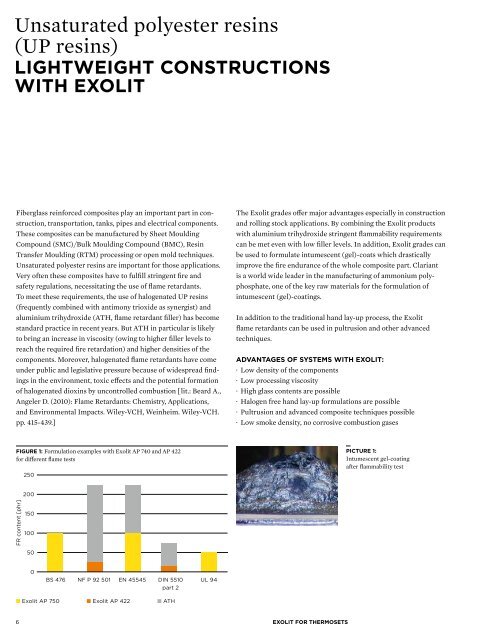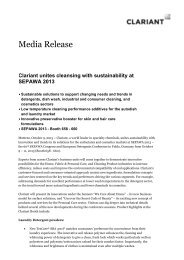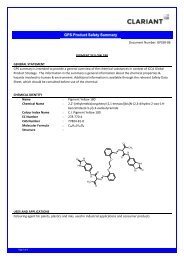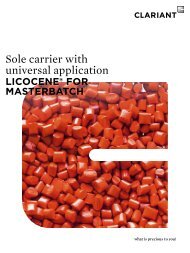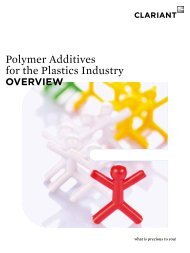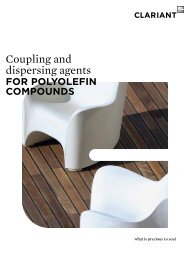Exolit® for
ExOLIT FOR THERMOSETS - Clariant
ExOLIT FOR THERMOSETS - Clariant
- No tags were found...
Create successful ePaper yourself
Turn your PDF publications into a flip-book with our unique Google optimized e-Paper software.
Unsaturated polyester resins<br />
(UP resins)<br />
Lightweight constructions<br />
with Exolit<br />
Fiberglass rein<strong>for</strong>ced composites play an important part in construction,<br />
transportation, tanks, pipes and electrical components.<br />
These composites can be manufactured by Sheet Moulding<br />
Compound (SMC)/Bulk Moulding Compound (BMC), Resin<br />
Transfer Moulding (RTM) processing or open mold techniques.<br />
Unsaturated polyester resins are important <strong>for</strong> those applications.<br />
Very often these composites have to fulfill stringent fire and<br />
safety regulations, necessitating the use of flame retardants.<br />
To meet these requirements, the use of halogenated UP resins<br />
(frequently combined with antimony trioxide as synergist) and<br />
aluminium trihydroxide (ATH, flame retardant filler) has become<br />
standard practice in recent years. But ATH in particular is likely<br />
to bring an increase in viscosity (owing to higher filler levels to<br />
reach the required fire retardation) and higher densities of the<br />
components. Moreover, halogenated flame retardants have come<br />
under public and legislative pressure because of widespread findings<br />
in the environment, toxic effects and the potential <strong>for</strong>mation<br />
of halogenated dioxins by uncontrolled combustion [ lit.: Beard A.,<br />
Angeler D. (2010): Flame Retardants: Chemistry, Applications,<br />
and Environmental Impacts. Wiley-VCH, Weinheim. Wiley-VCH.<br />
pp. 415-439. ]<br />
The Exolit grades offer major advantages especially in construction<br />
and rolling stock applications. By combining the Exolit products<br />
with aluminium trihydroxide stringent flammability requirements<br />
can be met even with low filler levels. In addition, Exolit grades can<br />
be used to <strong>for</strong>mulate intumescent (gel)-coats which drastically<br />
improve the fire endurance of the whole composite part. Clariant<br />
is a world wide leader in the manufacturing of ammonium polyphosphate,<br />
one of the key raw materials <strong>for</strong> the <strong>for</strong>mulation of<br />
intumescent (gel)-coatings.<br />
In addition to the traditional hand lay-up process, the Exolit<br />
flame retardants can be used in pultrusion and other advanced<br />
techniques.<br />
Advantages of systems with Exolit:<br />
· Low density of the components<br />
· Low processing viscosity<br />
· High glass contents are possible<br />
· Halogen free hand lay-up <strong>for</strong>mulations are possible<br />
· Pultrusion and advanced composite techniques possible<br />
· Low smoke density, no corrosive combustion gases<br />
Figure 1: Formulation examples with Exolit AP 740 and AP 422<br />
<strong>for</strong> different flame tests<br />
250<br />
Picture 1:<br />
Intumescent gel-coating<br />
after flammability test<br />
200<br />
FR content [phr]<br />
150<br />
100<br />
50<br />
0<br />
BS 476 NF P 92 501 EN 45545 DIN 5510<br />
part 2<br />
UL 94<br />
n Exolit AP 750 n Exolit AP 422 n ATH<br />
6<br />
Exolit <strong>for</strong> Thermosets


